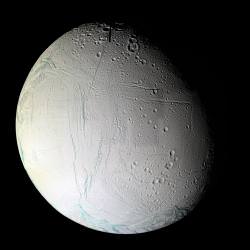 You’d think it would be an easy question to answer: how long is Saturn’s day? But it’s been a puzzle for astronomers for many years. On other gas planets, astronomers just measure the rotation of their magnetic fields. The problem is that the Ringed Planet’s field rotates slower than the rest of the planet, and it changes.
You’d think it would be an easy question to answer: how long is Saturn’s day? But it’s been a puzzle for astronomers for many years. On other gas planets, astronomers just measure the rotation of their magnetic fields. The problem is that the Ringed Planet’s field rotates slower than the rest of the planet, and it changes.
A new study proposes that Saturn’s icy moon Enceladus might be the culprit. Astronomers have recently discovered that the moon ejects geysers of water ice into orbit around Saturn. These particles form a doughnut shaped ring around Saturn and become electrically charged. And this might weigh down the planet’s magnetic field, slowing it down slightly.
The length of Saturn’s day has grown by 6 minutes from when NASA’s Voyager spacecraft first arrived in the early 1980s to Cassini’s arrival. It might be that Enceladus was less active during this period, so it was ejecting less particles to slow Saturn down.
Original Source: Imperial College News Release
